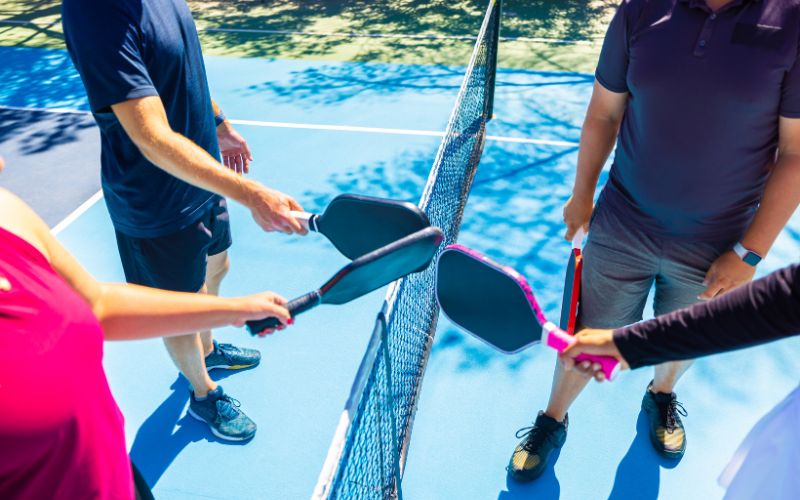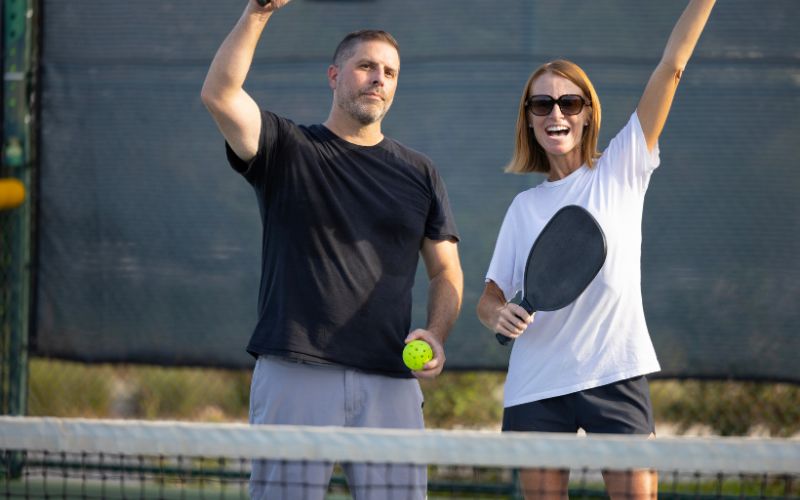Pickleball, a rapidly growing sport that combines elements of tennis, badminton, and table tennis, has gained immense popularity over recent years. A crucial aspect of the game is the type of ball used, which significantly impacts gameplay and performance. In this comprehensive guide, we will answer what type of ball is used in pickleball including their characteristics, suitability for indoor and outdoor play, and key considerations for players.
Understanding Pickleball Balls
The initial version of pickleball originated with the use of Wiffle balls. Initially, players utilized ping pong paddles and a Wiffle ball on an old badminton court to play the sport. As pickleball evolved, so did the equipment, but the ball used in the game retained elements reminiscent of a Wiffle ball.
Pickleball balls are specifically designed to meet the unique requirements of the sport. They are perforated plastic balls with various features tailored to enhance gameplay and ensure a consistent experience for players across different environments.
Outdoor Pickleballs
Outdoor pickleballs are engineered to withstand the rigors of outdoor play. They are designed with durability and resilience in mind, making them suitable for rough surfaces and varying weather conditions.
Outdoor balls tend to have larger holes compared to their indoor counterparts. These larger holes contribute to better aerodynamics, allowing the ball to perform well even in windy conditions. Moreover, outdoor balls tend to be slightly heavier, which helps them resist wind interference and maintain a stable flight path.
Indoor Pickleballs
Indoor pickleballs are optimized for use in indoor courts, where environmental factors such as wind interference are not a concern. These balls are typically lighter and have smaller holes compared to outdoor balls, allowing for smoother gameplay on indoor surfaces.
Indoor pickleball prioritizes consistent bounce and control, making them ideal for precise shots and rallies in indoor settings. They are often made from softer plastic to ensure a quieter and more controlled playing experience, especially in indoor environments where noise levels need to be minimized.
Key Differences Between Indoor and Outdoor Balls
The distinction between indoor and outdoor pickleballs lies primarily in their design and composition, tailored to accommodate the unique challenges posed by each playing environment.
Hole Size and Distribution
One of the most noticeable differences between indoor and outdoor pickleballs is the size and distribution of the holes. Outdoor balls feature larger, circular holes, whereas indoor balls have smaller perforations. These differences affect aerodynamics, flight stability, and overall performance on different surfaces.
Material and Durability
Outdoor pickleballs are constructed from durable materials capable of withstanding the demands of outdoor play. They are engineered to endure rough surfaces and harsh weather conditions, ensuring longevity and consistent performance over time. In contrast, indoor balls prioritize softer materials to minimize noise and maintain playability on indoor courts.
Weight and Bounce
Weight and bounce characteristics also vary between indoor and outdoor pickleballs. Outdoor balls are slightly heavier to counter wind interference and maintain a steady trajectory during outdoor play. Indoor balls, on the other hand, are lighter and offer a more controlled bounce, facilitating precise shots and maneuverability in indoor settings.
Choosing the Right Pickleball Ball
Selecting the appropriate pickleball ball depends on various factors, including playing environment, skill level, and personal preferences. Whether playing indoors or outdoors, players should consider the following factors when choosing pickleball balls:
Playing Surface and Conditions
The type of playing surface and prevailing conditions significantly influence ball selection. Outdoor balls are designed to perform well on rough outdoor surfaces and in windy conditions, whereas indoor balls excel on smooth indoor courts with minimal environmental interference.
Player Skill Level
Novice players may prefer softer balls with slower pace, allowing for easier control and consistent performance during rallies. Advanced players, on the other hand, may opt for faster, more responsive balls that enhance the intensity and pace of gameplay.
Tournament Regulations
For competitive play, players must adhere to official ball regulations established by governing bodies such as the USA Pickleball Association (USAPA). Approved balls must meet specific size, weight, and performance standards to ensure fair and consistent competition across tournaments.
Differences Between Pickleball and Tennis Balls
Pickleball and tennis are both racket sports that involve hitting a ball over a net, but they differ significantly in various aspects including equipment, court size, and playing style. Here are the key differences between pickleball and tennis balls:
1. Size and Weight:
- Pickleball Ball: Pickleball balls are smaller and lighter compared to tennis balls. They are typically made of perforated plastic and have a diameter of about 2.87 inches.
- Tennis Ball: Tennis balls are larger and heavier than pickleball balls. They are made of rubber covered in felt and have a diameter of about 2.7 inches.
2. Bounce and Speed:
- Pickleball Ball: Pickleball balls have a lower bounce and travel at a slower speed compared to tennis balls. This allows players to have more control over the ball and facilitates longer rallies.
- Tennis Ball: Tennis balls have a higher bounce and travel at a faster speed due to their heavier weight and solid construction. This results in a more dynamic and fast-paced game.
3. Court Size and Dimensions:
- Pickleball Court: Pickleball courts are smaller than tennis courts, measuring 20 feet wide and 44 feet long for doubles play, and 20 feet wide and 22 feet long for singles play.
- Tennis Court: Tennis courts are larger, measuring 27 feet wide for singles play and 36 feet wide for doubles play, with lengths varying between 78 and 78.5 feet.
4. Equipment:
- Pickleball: Pickleball is typically played with solid paddles made of wood, composite materials, or graphite. Players use these paddles to hit the perforated plastic pickleball over the net.
- Tennis: Tennis is played with strung rackets made of graphite, aluminum, or other materials. Players use these rackets to hit the rubber tennis ball over the net.
5. Playing Style:
- Pickleball: Pickleball emphasizes quick reflexes, precision shots, and strategic placement. Players often engage in dinking, which involves soft shots placed close to the net to outmaneuver opponents.
- Tennis: Tennis is characterized by powerful serves, groundstrokes, and volleys. Players use a combination of spin, pace, and placement to outplay their opponents and win points.
Differences Between Pickleball and Ping Pong Balls
Pickleball and ping pong (table tennis) are both popular racket sports, but they differ significantly in terms of equipment, playing style, and court size. Here are the key differences between pickleball and ping pong balls:
1. Size and Weight:
- Pickleball Ball: Pickleball balls are larger and heavier compared to ping pong balls. They typically have a diameter of about 2.87 inches and are made of perforated plastic.
- Ping Pong Ball: Ping pong balls, also known as table tennis balls, are much smaller and lighter than pickleball balls. They have a diameter of about 1.57 inches and are made of celluloid or plastic.
2. Bounce and Speed:
- Pickleball Ball: Pickleball balls have a lower bounce and travel at a slower speed compared to ping pong balls. This allows for more controlled shots and longer rallies in pickleball.
- Ping Pong Ball: Ping pong balls have a higher bounce and move at a faster pace due to their lightweight construction. This results in quick exchanges and rapid gameplay in ping pong.
3. Court Size and Dimensions:
- Pickleball Court: Pickleball courts are larger than ping pong tables. A standard pickleball court measures 20 feet wide and 44 feet long for doubles play, and 20 feet wide and 22 feet long for singles play.
- Ping Pong Table: Ping pong tables are much smaller, measuring 5 feet wide, 9 feet long, and 2.5 feet high. The compact size of the table requires quick reflexes and precise shots in ping pong.
4. Equipment:
- Pickleball: Pickleball is played with solid paddles made of wood, composite materials, or graphite. These paddles are larger and heavier compared to ping pong paddles.
- Ping Pong: Ping pong, or table tennis, is played with smaller and lighter paddles specifically designed for the game. Ping pong paddles are typically made of wood with rubber coverings on both sides.
5. Playing Style:
- Pickleball: Pickleball emphasizes strategy, placement, and controlled shots. Players engage in dinking, volleying, and smashing to outmaneuver opponents and win points.
- Ping Pong: Ping pong is known for its fast-paced rallies, spin shots, and quick reflexes. Players use a combination of topspin, backspin, and sidespin to outplay their opponents and score points.
Conclusion
In conclusion, the type of ball used in pickleball plays a critical role in shaping the playing experience and overall enjoyment of the game. Whether playing indoors or outdoors, selecting the right pickleball ball is essential for optimizing performance and maximizing enjoyment on the court. By understanding the key differences between indoor and outdoor balls and considering factors such as playing environment and skill level, players can make informed decisions when choosing pickleball balls for their next game.
FAQs About Pickleball Balls
1. What type of ball is traditionally used in pickleball?
The original version of pickleball utilized a Wiffle ball along with ping pong paddles on a converted badminton court.
2. What are the key differences between indoor and outdoor pickleball balls?
Indoor pickleballs typically have smaller holes and are lighter, prioritizing controlled bounce and quieter play. Outdoor balls, on the other hand, have larger holes, are slightly heavier, and are designed for durability and stability in windy conditions.
3. How do outdoor pickleballs perform in windy conditions?
Outdoor pickleballs are designed with larger holes and slightly heavier weight to resist wind interference, ensuring a stable flight path even in windy conditions.
4. What factors should I consider when choosing a pickleball ball?
When selecting a pickleball ball, consider the playing environment, skill level, and tournament regulations. Factors such as surface type, player preference, and adherence to official regulations can influence your choice.
5. Are there specific regulations regarding pickleball balls in tournaments?
Yes, competitive pickleball tournaments enforce regulations set by governing bodies like the USA Pickleball Association (USAPA). Approved balls must meet specific size, weight, and performance standards to ensure fair and consistent gameplay across tournaments.







